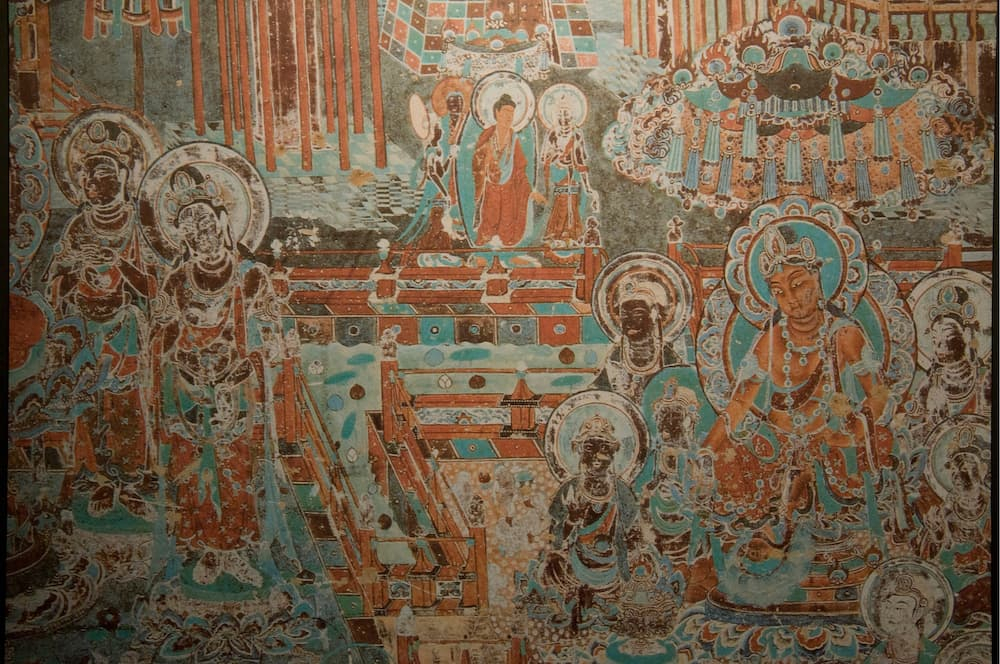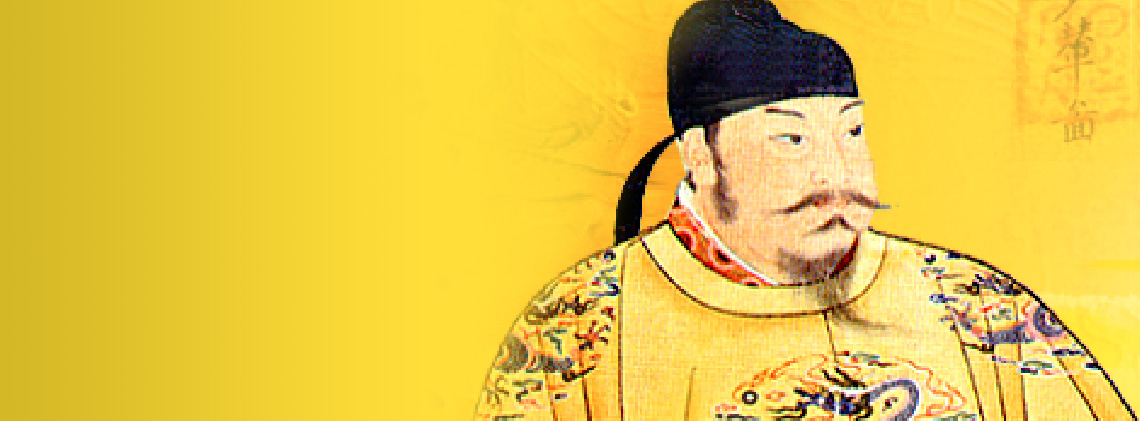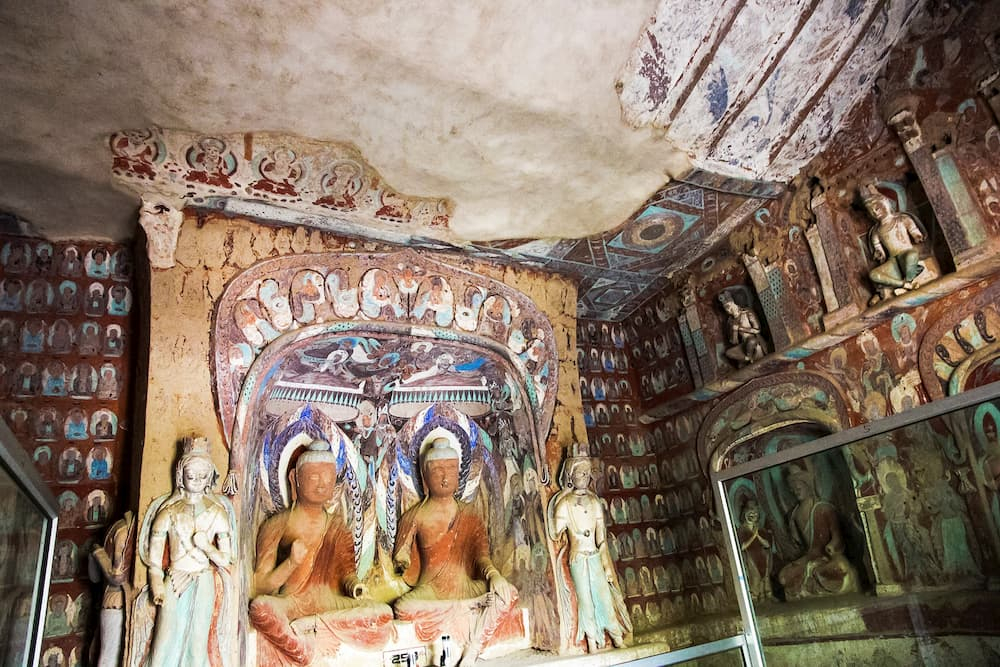
Abundant Dunhuang, Brilliant Life
Splendid
Chi Culture
Topic
Abundant Dunhuang, Brilliant Life
Ancient artworks and documents serve as tangible records of historical life scenes. The murals and manuscripts discovered in the world-famous Dunhuang Caves are not only significant cultural heritage of China but also a historical treasure highly esteemed by the international academic community. Examining Dunhuang artefacts allows us to understand various facets of ancient society, particularly the Tang Dynasty. Dunhuang artefacts provide valuable insights into different aspects of the Tang Dynasty life, including decoration, wedding customs, childbirth practices, divorce issues, funeral traditions, and daily routines.
In the Dunhuang Caves, multiple murals portray men and women from the dynasty, reflecting their attire and providing a glimpse into the social fabric of that era. In the Tang Dynasty, women were fond of wearing pomegranate skirts (Shiliuqun) and paid great attention to their eyebrow makeup. They also wore wigs, adorned their faces with floral patches, and typically did not wear earrings. Women also embraced wearing masculine attire, with robe-style garments inspired by Hu clothing (Hufu) being a popular choice. This demonstrates the open and inclusive social atmosphere of the Tang Dynasty. In that era, men's clothing was primarily divided into ceremonial and everyday wear. Ceremonial attire included loose robes with large sleeves and a cross collar that overlapped on the front and closed on the right side, while everyday wear comprised a headscarf (Futou), round-collared robe, leather belt, and tall boots. Due to frequent interactions with the Hu people during the Tang Dynasty, the Hu clothing significantly impacted Tang clothing. Collared robes with narrow sleeves, both long and short, and the combination of upper jackets or coats and lower trousers known as "kuzhe", were prevalent in men's fashion during that period. These styles were embraced not only by commoners but were also mandated by Emperor Taizong, who required all officials to wear "kuzhe" attire when attending court on the first and fifteenth days of the lunar month.
Marriage is a momentous occasion in life, as true in ancient times as it is today. The Dunhuang murals also showcase ancient wedding ceremonies, with one particularly portraying a marriage between a Tubo man and a Han Chinese woman. The wedding took place in a tent known as Qinglu (also called Baizi Tent), where the couple performed rituals and stayed overnight. As early as the Eastern Han Dynasty to the Tang Dynasty, it was customary to hold weddings in Qinglu. During the wedding ceremony in Qinglu, the groom must perform the kowtow ritual by kneeling and bowing, whereas the bride only bowed with folded hands.
In ancient times, it was common for people to plan on having children after marriage. Following a baby's birth, there was a customary practice called "xi san zhao" (washing on the third day), where the infant was bathed three days after birth. This tradition originates from the legend of the Nine Dragons spraying water during the birth of Sakyamuni, known as the Buddha. This custom was extremely popular from the Sui and Tang Dynasties to the Five Dynasties, and it wasn't until the Song Dynasty that the practice was changed to a full-moon-birth feast. For parents, the lengthy process of child-rearing is the true challenge. In the Dunhuang murals, an image of a baby carriage has been found with a safety harness resembling modern-day strollers. It is fascinating to see that people from over a thousand years ago already possessed such practical life wisdom.
In ancient times, fortunate babies could enjoy a happy upbringing at home, while unfortunate ones might have been sold by their parents due to economic difficulties and the inability to support them. Multiple child-selling contracts have been found in the Dunhuang manuscripts, detailing the process through which impoverished families sold their children. Some resorted to selling their children in exchange for food due to financial difficulties caused by home flooding, while others, left without the means to care for their sons after their husbands' deaths, sadly sold the sons into lifelong servitude to others. The bitterness of these experiences is unmistakably revealed in the contracts.
Aside from child-selling, there were divorce issues in ancient times. Several divorce notes that husbands wrote to their wives have also been found among the Dunhuang manuscripts. In ancient times, divorce took place in three main scenarios: 1) State-mandated annulment of marriage, known as "criminal annulment"; 2) Mutual agreement due to marital disagreements, known as "mutual divorce"; 3) Unilateral divorce initiated by the husband, referred to as "repudiation". In the Dunhuang manuscripts, the prevalent type of divorce was mutual divorce. The extant texts consist of divorce notes and separation agreements between spouses, which required signatures or seals from both parties, their relatives, and neighbours to be considered valid.
With advancing age, one must confront the impending arrival of death. This has always been true; from time immemorial, no individual has been able to escape the inevitable reality of mortality. The Dunhuang murals depict ancient funeral scenes, especially among nomadic tribes in the Western Regions. Following the death of a respected elder or leader, mourners would express their grief by engaging in acts of self-mutilation, such as cutting their ears, and noses, or piercing their chests during the burial ceremony.






